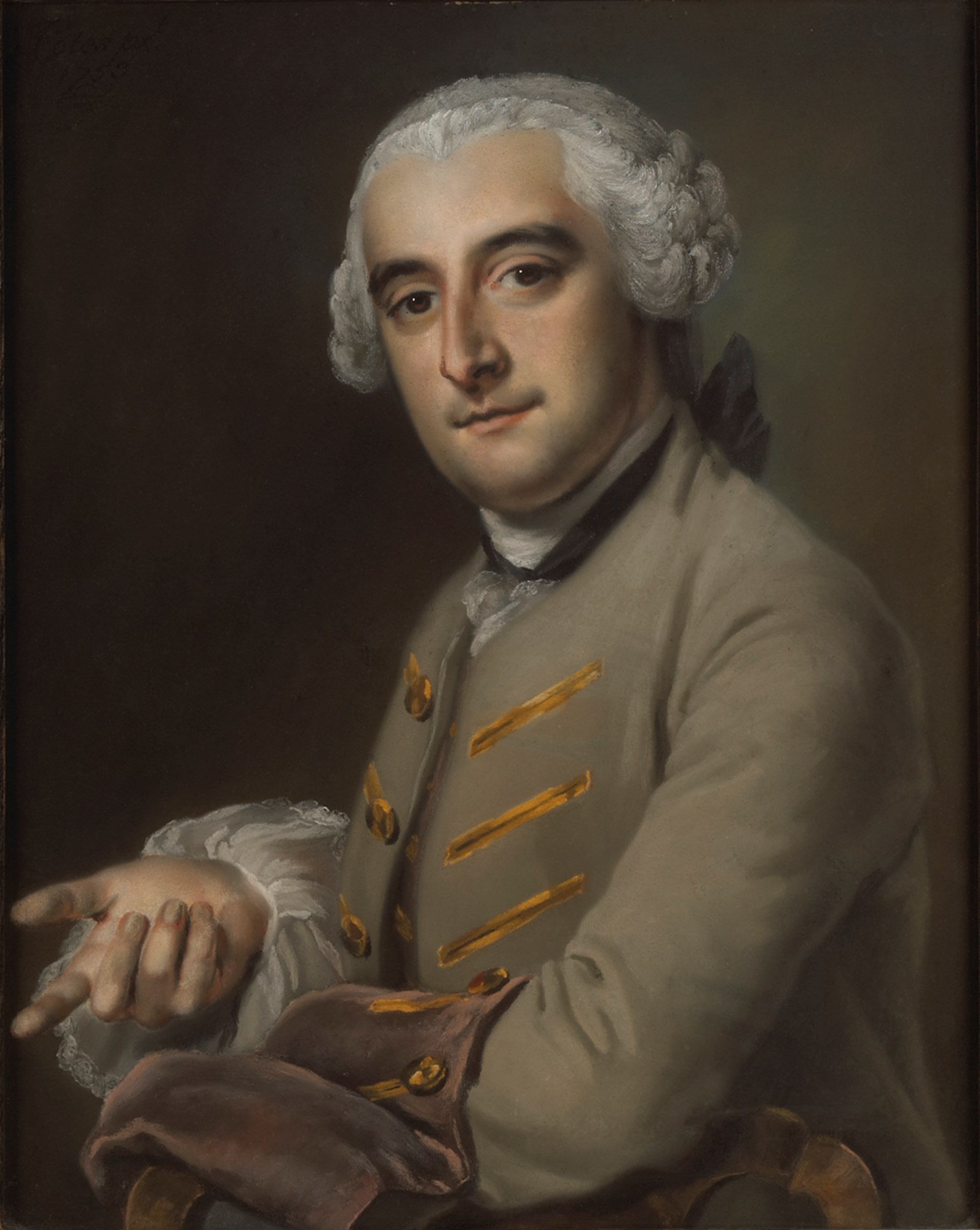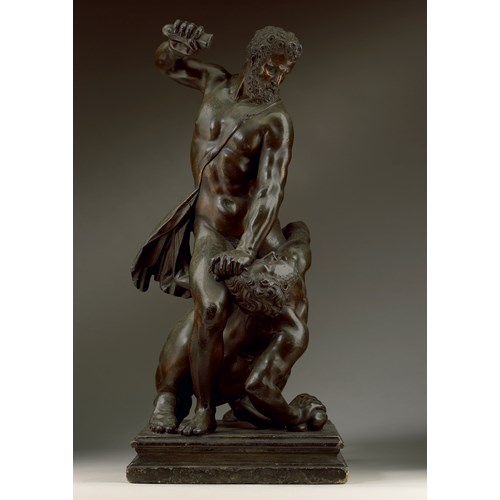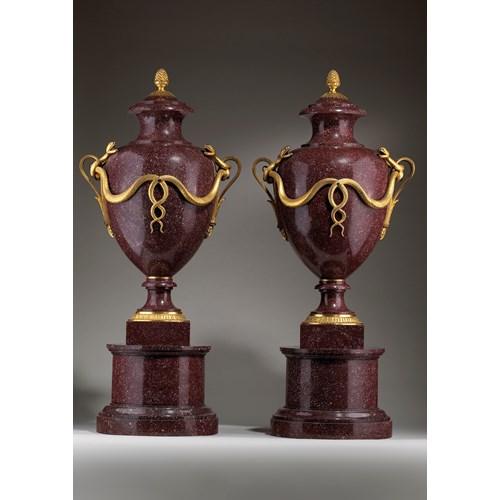Francis Cotes R.A.
9. Portrait of a Gentleman
Medium Pastel on paper laid on canvas
Dimension 81 x 67.9 cm (31⁷/₈ x 26³/₄ inches)
Royal Academy of Arts. He rivalled Joshua Reynolds and Thomas Gainsborough in portrait painting before
his untimely death aged 44.
Born in London, the son of an apothecary, Cotes trained with the portrait painter George Knapton. He
then set up his own portrait studio, working chiefly with pastels, and quickly became the preeminent
British artist in this medium. Cotes recognised the commercial potential of having his works engraved and
sold as prints, which helped to further popularise his works.
In the late 1750s, Cotes also began painting in oils and by 1763 had started to employ Peter Toms, a
specialist drapery painter and future Royal Academician who also worked with Joshua Reynolds. From this
point on, the clothes worn by his sitters would typically be painted by Toms, while Cotes concentrated on
the figure and composition.
In 1767, Cotes was commissioned to paint Queen Charlotte with her infant daughter Charlotte, the
Princess Royal. The resulting portrait was hung by King George III in his bedchamber at Buckingham
House. The following year, Cotes was one of the leading artists who petitioned the King to approve the
formation of a Royal Academy of Arts, becoming a Founder Member. Cotes was proud of his new title,
usually adding “RA” to his signature thereafter.
Cotes exhibited 18 portraits in two years at the Royal Academy’s annual exhibitions. He died suddenly in
1770 at just 44 years old, after drinking a potion that he had believed would cure him of an illness, thought
to have been kidney or gallstones. Cotes’ fellow Royal Academician Mary Moser wrote that “many a tear
will drop on his grave, as he is not more lamented as an artist than a friend to the distressed”.
The present portrait is signed by Cotes and dated 1753. The sitter is identified as “Mr Gouch” or “Gootz”,
“a Spanish gentleman”, by a nineteenth-century label on the reverse of the board that protects the canvas
(top left). The label is handwritten in black ink, and records how a Portuguese exile gave the portrait to the
notary William Jacobson in Plymouth, and how the latter gifted it to Mrs Derwent Coleridge. The text is
transcribed in a later, type-written label also on the reverse (bottom centre). Mrs Derwent Coleridge
(d. 1887), was born Mary Simpson Pridham, the daughter of John Drake Pridham, whose wife was a first
cousin of William Jacobson. Mary Derwent Coleridge was the wife of Rev. Derwent Coleridge (1800-1883),
the son of the celebrated poet Samuel Taylor Coleridge (1772-1834). A stencilled Chrsitie’s stock number
on the reverse – GP270 – leads to the catalogue for the auction of the property of Edward Coleridge Gair
(1904-1987), which took place in London on 24th March 1987. The present pastel was lot 62. Mr Gair was
the son of George Herbert Gair (1871-1919) and Margaret Eulelia Coleridge (1878-1960), who was a
descendant of Mary Derwent Coleridge.
The circumstances of how William Jacobson came to be in possession of the present portrait in Plymouth
are fascinating if incomplete. The label states it was given to him by a Portuguese exile, and in 1829 Don
Miguel, Regent of Portugal, visited Plymouth, which subsequently gave asylum for several months to three
thousand of the adherents of Don Pedro of Brazil. Our Portuguese exile would likely have been amongst
them, but how the portrait came into his hands in the first place is open to speculation. The label identifies
the sitter, Mr Gouch or Gootz, as a Spanish gentleman. Records for the family name Gooch reveal that a
lady named Elizabeth Sarah Villa Real Gooch (born 1757), died in Plymouth in 1807. She was the daughter
of William Villa-Real, the scion of an important family of Jewish merchants originally from the Iberian
Peninsula, who died, aged 30, in 1759. The fact that Elizabeth Sarah Villa Real Gooch was from a family of
Spanish or Portuguese descent, that she died in Plymouth, and that she married a William Gooch in 1775,
suggest she may be the link between the sitter in the present portrait and the Portuguese exile who gifted
it to William Jacobson in Plymouth. What remains to be established is whether the sitter was Elizabeth’s
father, William Villa-Real (which would be plausible if we consider his age and the date on the portrait) or
a relative of her husband William Gooch, the second son of Thomas Gooch, Baronet of Benacre Hall in
Suffolk, incorrectly identified by the label as “a Spanish gentleman”.
Medium: Pastel on paper laid on canvas
Signature: Identified by a Label on the Reverse as “Mr Gouch”, possibly William Villa Real (1729-1759)
Dimension: 81 x 67.9 cm (31⁷/₈ x 26³/₄ inches)
Provenance: Possibly William Villa Real (1729-1759);
Possibly his daughter Elizabeth Sarah Villa Real Gooch (1757-1807), who died in Plymouth;
Presented to William Jacobson, solicitor at 5 Frankfort Street, Plymouth (Pigot & Co.'s Directory of
Berks, Bucks etc, 1844, p. 103) and president of the Plymouth Law Society in 1823, by a Portuguese exile
(according to a label on the reverse);
Presented by William Jacobson to Mrs Derwent Coleridge (d. 1887), née Mary Simpson Pridham, John
Drake Pridham’s daughter and the wife of Rev. Derwent Coleridge (1800-1883), the son of Samuel Taylor
Coleridge (1772-1834) (according to a label on the reverse);
Probably by descent to her son Ernest Hartley Coleridge (1846 – 1920);
Probably by descent to his daughter Margaret Eulelia Coleridge (1878-1960), who married George
Herbert Gair (b. 1871-1919) in 1903;
Edward Coleridge Gair (1904-1987); his sale, London, Christie’s, 24 March 1987, lot 62
Literature: N. Jeffares, Dictionary of Pastellists before 1800, p. 12
Plus d'œuvres d'art de la Galerie




, after the Antique_T637828580940275284.jpg?width=500&height=500&mode=pad&scale=both&qlt=90&format=jpg)



 (Workshop of)-48. Venus de ’Medici_T638969978893477355.jpg?width=500&height=500&mode=pad&scale=both&qlt=90&format=jpg)
